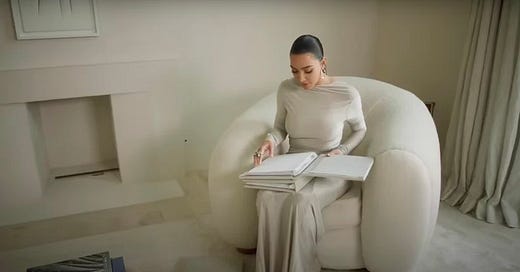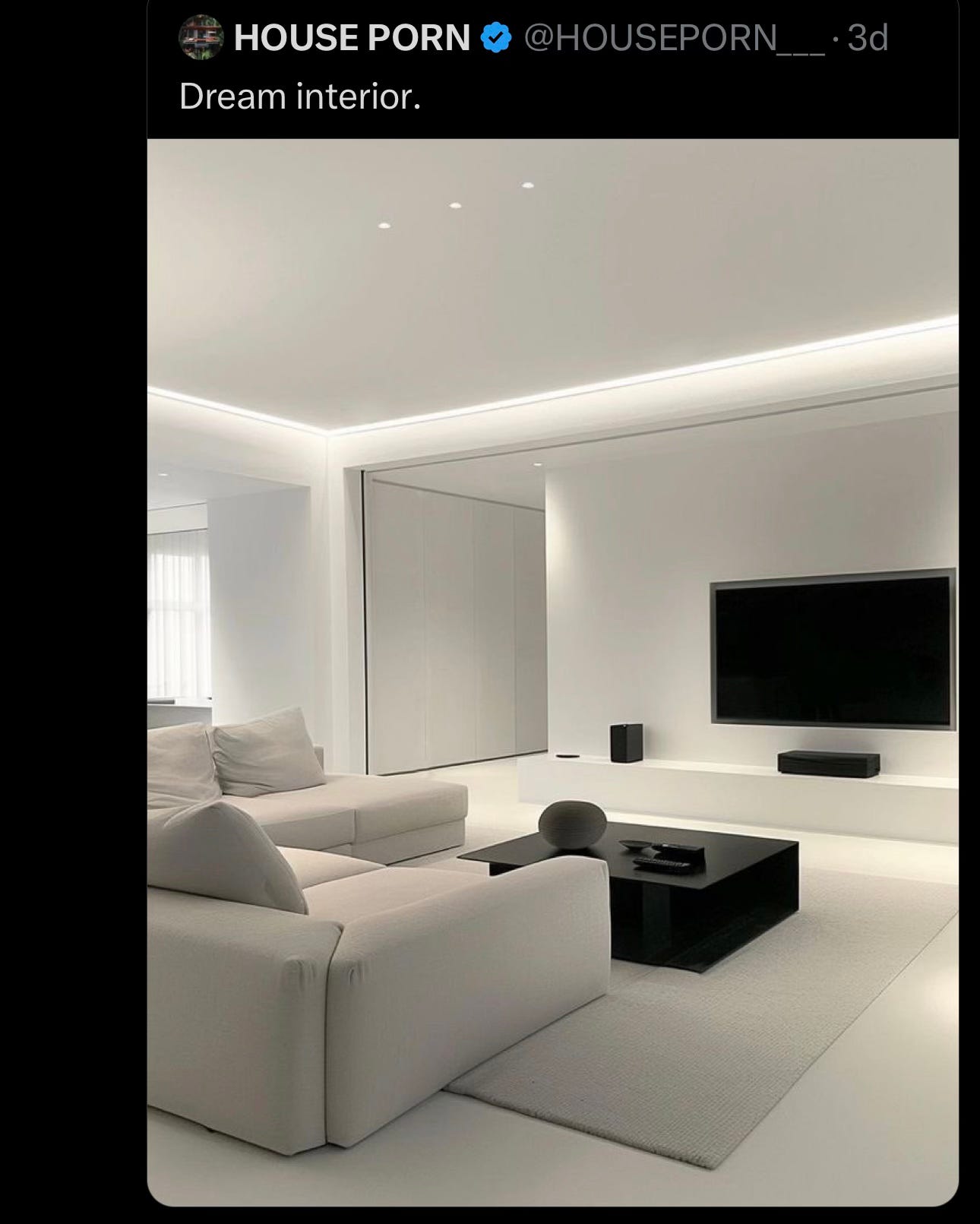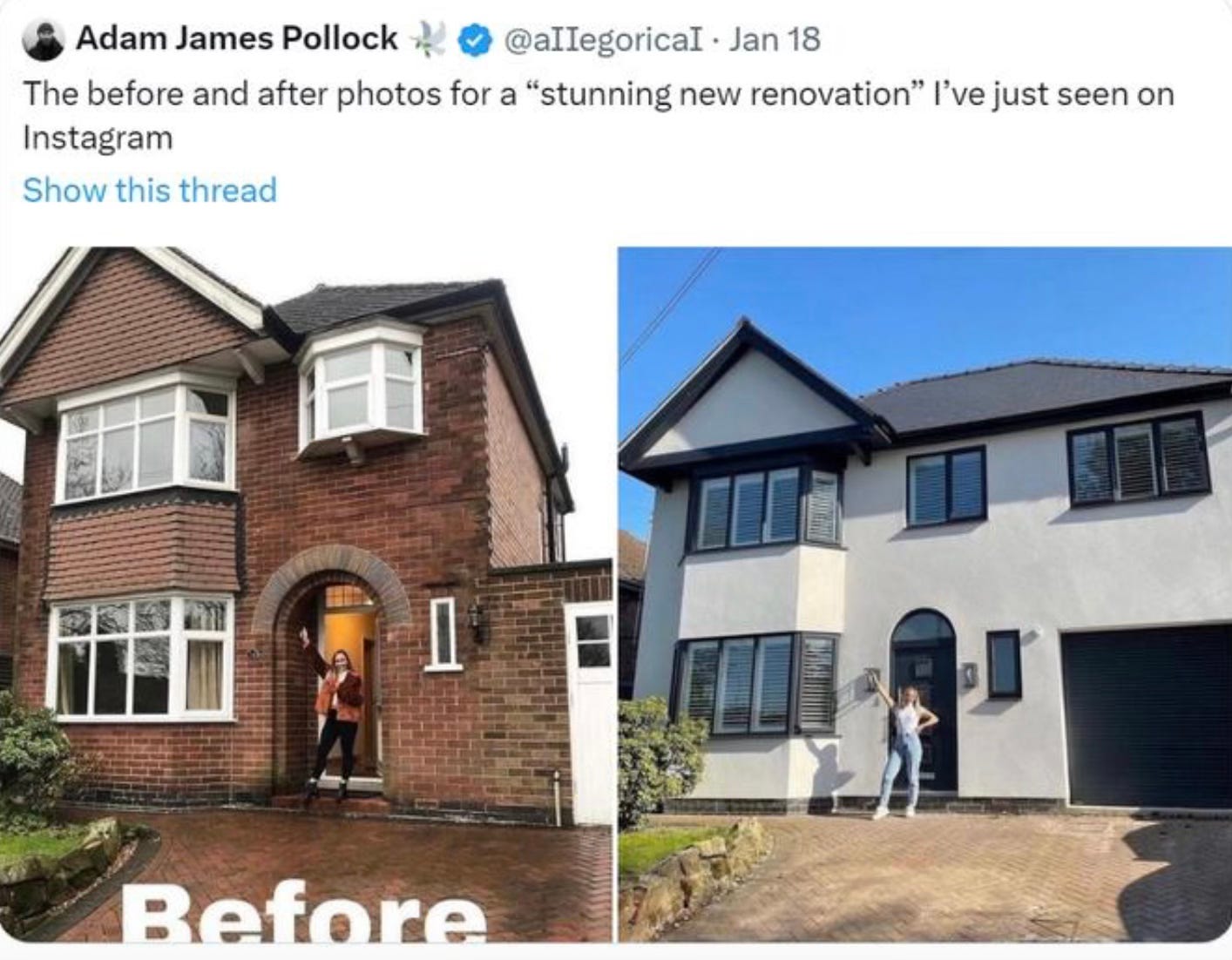WHY DO RICH PEOPLE’S HOMES LOOK LIKE THAT?
An in-depth exploration of behemothic empty spaces, scattered furniture, and depression-inducing shades of grey.
One of my favourite twitter corners - along with fashion history Twitter and silent movie Twitter - happens to be hideous interior design Twitter, and the other day I came across a sight to behold. Titled “dream interior”, the photo showed a sterile white cube of a room, devoid of anything but the basics: a white sofa, white led lights, a black coffee table, and of course a giant flat screen TV. “Dream interior”. Pad the walls, put me in there wearing a straitjacket and boom, you’ve got my worst fear right there.
The same night, at dinner, a friend told me about this couple he had met, who bonded with him over a passion for gardening (said couple had a garden at the centre of a notoriously expensive European capital). “I finally visited them. They had a big house, expensively decorated in beige and cream tones… and the garden was nothing but astroturf”. Turns out the couple loved to ‘garden’, but hated the feeling of dirt on their hands. I was fascinated.
I have obsessed over the interior design aesthetics of wealth for a while, ever since Vogue dropped that video of Kim and Kanye’s home in Calabasas, the one that took almost as long to furnish as Gaudí’s Sagrada Familia took to build. Before that, when I thought of a rich person’s home, my mind conjured images of Lee Radziwill’s and Diana Vreeland’s places, full to the brim with antiques, knick-knacks and personality. Suddenly here was this blank vessel, halfway between a Benedictine monk’s cellar and a super exclusive plastic surgery clinic, decorated with Rick Owens beds, sneaky Lucio Fontana artworks and fake Donald Judd tables (who says you can’t be a cheapskate just because you’re a billionaire). Why would anyone want to live in such barren environments?
“Simple: it’s a reflection of their personalities”, said my friend Nick when I asked him the question. Hard to argue with that. I mean, look at our billionaire overlords. Not much going on up there bar some 4th Reich fantasies and a determination so steely to amass even more money it would put Robin Hood’s Prince John to shame. But I think there’s more to it than that. It used to be that the nouveaux riches had a penchant for Versace towels and solid gold toilets, decorating their homes like more lavish versions of Versailles, prime examples being Donald Trump or Woody Allen in Small Time Crooks. That changed at some point in the 2010s, when the billionaires stopped trying to emulate Louis XIV and started trying to emulate Patrick Bateman instead. One psycho for another, I guess. What are they trying to signal, though?
Let’s take the ultimate billionaire abode, William Randolph Hearst’s San Simeon. Then let’s get rid of everything in it: the zoo, the Greek columns surrounding the big swimming pool, the Spanish-style iron work and tiles, the velvet sofas, the gilded painting frames. Now let’s also get rid of the ornate buildings themselves and replace them with huge white cubes illuminated from the ground up. Boom, you’ve got a desirable rich person’s home in 2025. Far from signaling abundance through an accumulation of objects, it’s about something more perfidious and more obscene.
It’s about taking up as much physical space as possible (a not too subtle reflection of the 1% hoarding a bigger and bigger percentage of global wealth every passing year), then leaving it as empty as possible. I suspect that trend started for “relatability” reasons (remember all those pandemic Zoom interviews? Damn them all to hell), but I also suspect they keep spaces empty because they know they are not precisely arbiters of good taste. No furniture = no possibility of us peasants mocking them (you gotta love the mega-rich being scared that we’ll laugh at them; meanwhile we’re only scared that they’ll destroy us).
I also suspect they want to signal something else: that they are a (private) jet setting elite who, rather than visit The Ritz, owns real estate all over the globe. An empty flat in London, another one in Paris, Madrid, Montecarlo, New York, Abu Dhabi, Moscow. Spread so thin among so many properties, who has the time to lovingly decorate any one of them?
As for the endless shades of white, cream and, above all, grey that remind me of that one Ab Fab episode, well, the lighter your place is, the more it has to be kept spotless by an army of help. Same goes for all of their other decorative idiosyncrasies: the ceilings so tall they rival Notre-Dame’s. The concrete floors. The humongous chef kitchens in which nothing more complicated than a garden salad is ever cooked. The two-story entryways that display all the space at once (very much the opposite of a secret passageway hidden behind a bookcase. Not that the 1% keep books at their homes, and if they do, they sort them by colour - looking at you, Dua Lipa).
Of course, as much as they would like to think otherwise, the uber-rich don’t live in a vacuum, which means their hideous interior design tastes trickle down to middle class homes everywhere like so much cerulean blue. I see it in the corner of Spanish suburbia where I grew up and where my parents still live: pretty Provençal-style houses in shades of yellow, pink, red and blue with cypress gardens are increasingly punctuated by big cubes of millennial grey and, you guessed it, astroturf. Speaking of which, according to a bunch of articles I read, millennials came of age in the 2010s, got tired of their parents’ homely Home Alone-style 90s houses, and decided to go in the complete opposite direction. Also according to articles, the increasingly grey, increasingly angular, increasingly Ikea-ified home décor we currently see is happening because of our generation’s love for Bauhaus and mid-century design. Only the look isn’t Bauhaus so much as a Bauhaus-from-memory sketch that has been xeroxed a dozen times.
Also, I truly believe younger people loving grey (who loves grey!?) isn’t as much the illness as it is a symptom. One of many, including the way fast food restaurants and movie theatres now look like office buildings; the Sans Serif-ication of logos wherever you look; Apple computers going from blobby and pop to industrial-inspired; and the fact that colour is just generally being sucked out of everything. The sterile, empty homes are but a reflection of the gentrification of our cities, now almost fully seized by the ruling class and turned into… a corporate landscape.
Because, at the end of the day, this aesthetic is all about efficiency. It’s about market research, about increasing sales and profits without “unnecessarily” increasing expense. It’s about “streamlining”, whatever that is.
Well, well, well; isn’t it funny that the imagined colour and look of life under communism has ended up revealing itself to be the actual hue and style of rampant, unchecked capitalism?








J’ai adoré ! J’ai aussi vu une vidéo qui expliquait que le beige/le vide permettaient aussi de retoucher les photos (et donc les corps) plus facilement 👀 Mais comme pour le 73 questions de Vogue ou les maisons AD, je me demande toujours s’il ne s’agit pas des maisons témoins de célébrités et qu’ils ont quelque part une autre vraie maison dans laquelle elles vivent (fashion & complotism 😂)